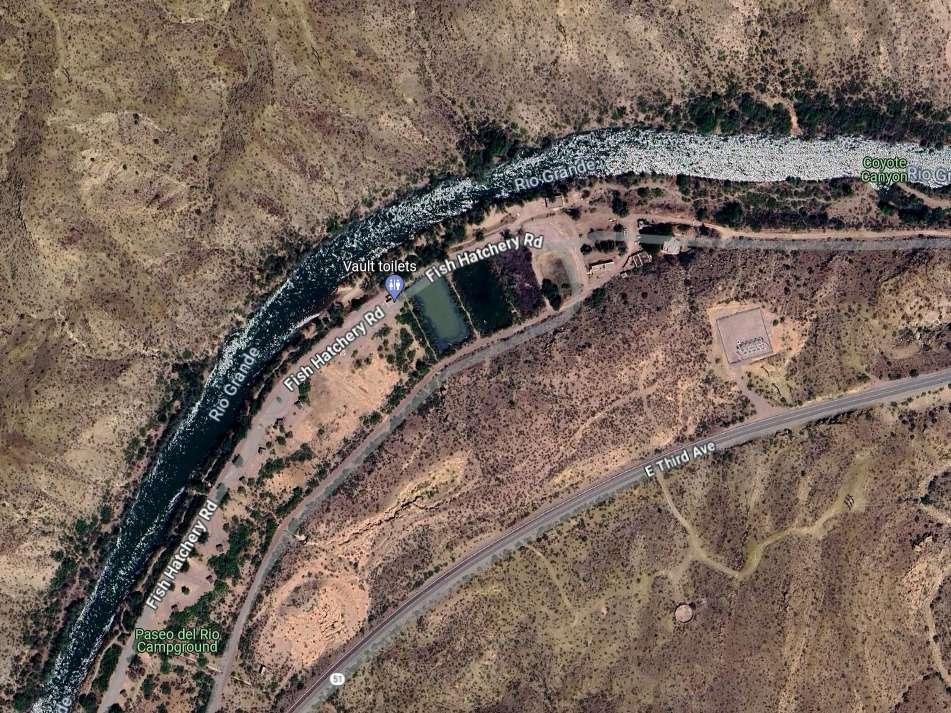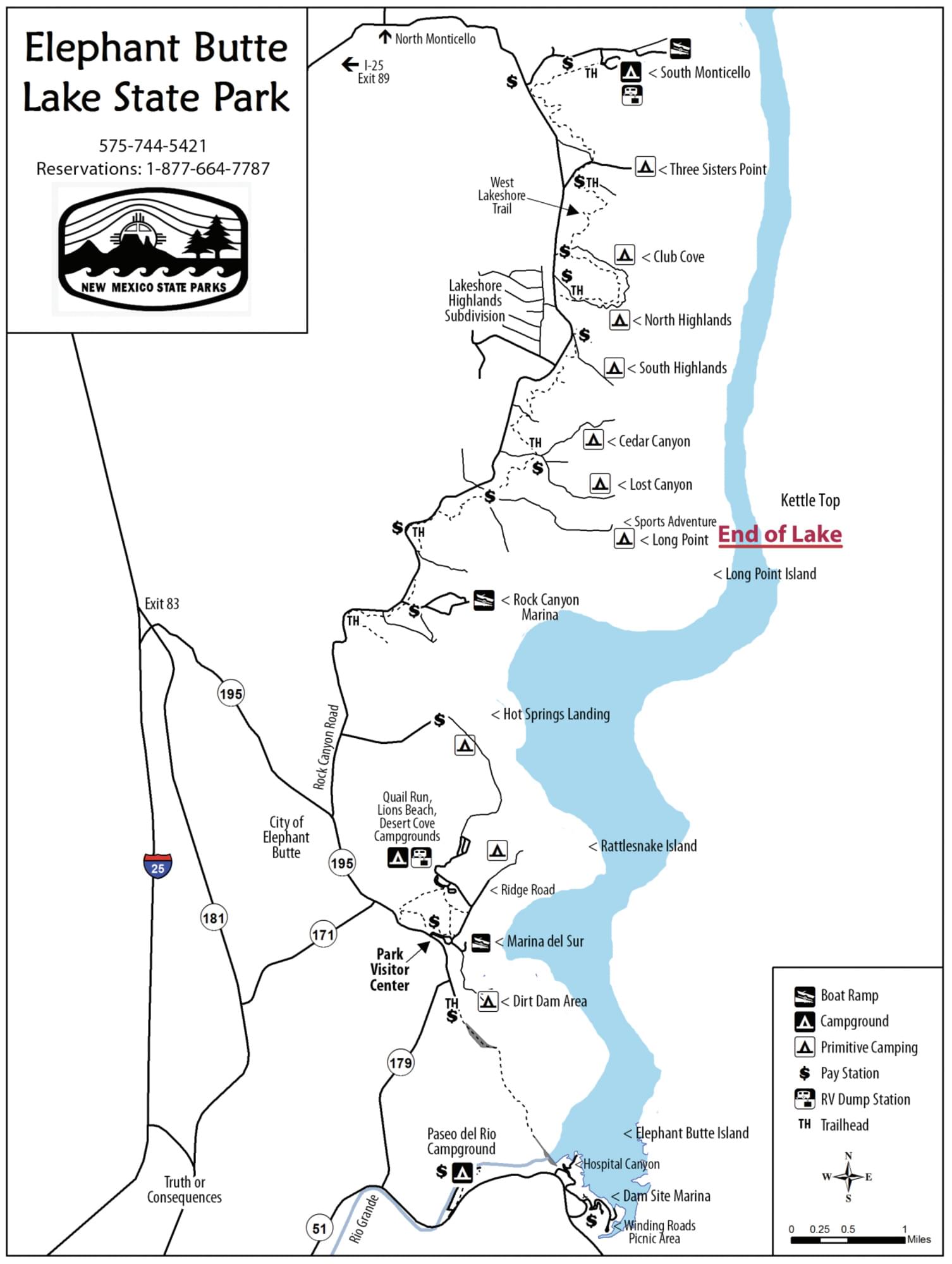Elephant Butte Lake SP--Paseo del Rio

Elephant Butte Lake SP--Paseo del Rio
Elephant Butte, New Mexico 87935
Elephant Butte Lake State Park Important Bird AreaElephant Butte Lake State Park webpage
Elephant Butte Lake State Park map
Elephant Butte Lake State Park trail map
Tips for Birding
This hotspot has by far the most species recorded of all the many location-specific hotspots in the park.
Birds of Interest
Common Nighthawk (rarely, late April & early May)
Black-chinned is the most common hummingbird species, typically found April-May and August-September. Broad-tailed is less frequently observed during the same period. Rufous has been reported rarely in August-September.
There have been rare listings of California Gull (December-January).
Willow Flycatcher (occasional, May and August-September).
Bell’s Vireo (common April-September). Woodhouse’s Scrub-Jay (October-April).
Cactus Wren (September-May).
Yellow-headed Blackbird (occasional, May-September).
Scott’s Oriole (rarely, April-May).
Virginia’s Warbler (April-May and August-September).
Pyrrhuloxia (all year)
About this Location
Paso del Rio Fish Hatchery is located within Elephant Butte State Park in New Mexico, offering visitors a unique opportunity to witness fish conservation efforts in action. Managed by the New Mexico Department of Game and Fish, the hatchery plays a crucial role in stocking fish populations in the state's waterways, including Elephant Butte Lake. Visitors can explore the hatchery facilities and learn about the various stages of fish production, from egg incubation to juvenile fish rearing.
Additionally, the campground at Elephant Butte State Park provides a convenient place for outdoor enthusiasts to stay while enjoying the natural beauty of the area. With scenic views of Elephant Butte Lake and opportunities for fishing, boating, hiking, and wildlife viewing, the campground offers a memorable outdoor experience for visitors of all ages.
About Elephant Butte Lake State Park
See all hotspots at Elephant Butte Lake State Park
The National Audubon Society has designated Elephant Butte Lake State Park as an Important Bird Area.
If you like camping, fishing, boating, or just being outdoors, Elephant Butte is for you. There is plenty of water and plenty of beach room at New Mexico’s largest State Park. Elephant Butte Lake can accommodate watercraft of many styles and sizes: kayaks, jet skis, pontoons, sailboats, ski boats, cruisers, and houseboats. Remember to wear your life jacket. Boat safe and boat smart! Besides sandy beaches, the State Park offers restrooms, picnic areas, playgrounds, and developed sites with electric and water hookups for RVs.
This park is prime for waterbirds and shorebirds. Elephant Butte is the largest lake in New Mexico and is best birded between September and May. At the lake, you may see American white pelicans, thousands of western and Clark’s grebes, several terns, and unusual gulls. Some of the better birding spots are at the marinas at Long Point, Three Sisters Point, and South Monticello Point (check for shorebirds, gulls, terns, waders, and ducks). Loons are more common at the southern end of the lake. Birding on land is best from Rock Canyon south, where tall scrub and houses with plants and feeders attract numerous species. Check migrating horned lark flocks for longspurs.
Elephant Butte Lake State Park Important Bird Area
Elephant Butte Reservoir, the largest lake in New Mexico, is a large, deep reservoir with fluctuating water levels. Elephant Butte, created by a dam in 1916 across the Rio Grande, was constructed to provide for irrigation and flood control. The lake is 40 miles long with more than 200 miles of shoreline. The area surrounding the lake is almost wholly managed by NM State Parks. The Bureau of Reclamation, however, controls the water levels.
State Park Headquarters is 5 miles north of Truth or Consequences on Exit 83 off I-25. Maps are available at Park Headquarters.
The site hosts the largest concentration of wintering Aechmophorus grebes in the state (winter 1993-98, 6000 individuals average, 15300 individuals maximum). Large numbers of gulls and other water birds migrate through and winter here. When water levels are low, large shorebird numbers may congregate in appropriate areas in migration. Attracts large numbers of rarer water birds.
Features
Restrooms on site
Entrance fee
Content from Elephant Butte Lake State Park webpage, John Montgomery, and Elephant Lake State Parks Important Bird Area webpage
Last updated April 4, 2024
